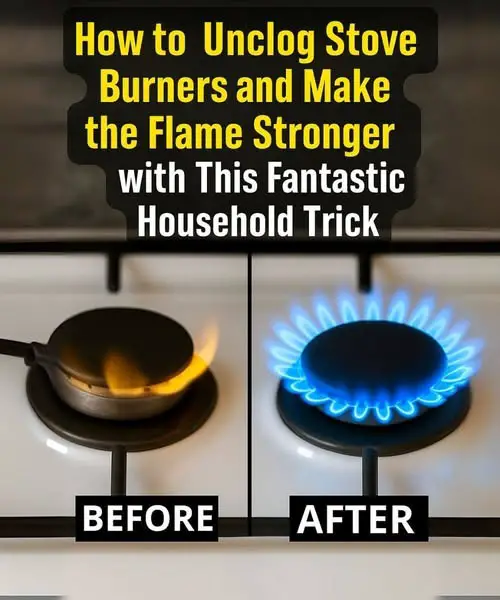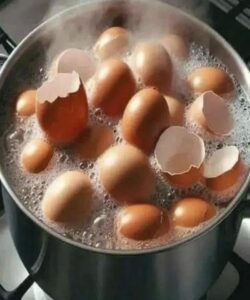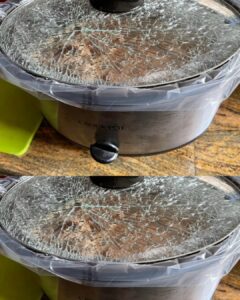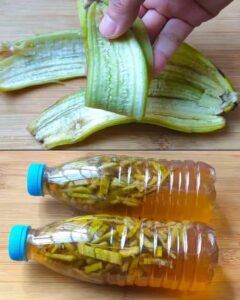
First of all—thank you. If you’re here, you’re probably like me: someone who takes pride in keeping their kitchen clean, functional, and safe. And for that, I’m genuinely grateful to be part of your journey to make your cooking space better.
There’s something oddly satisfying about fixing things with your own two hands, right? Especially when it saves you the time, money, and frustration of calling in a repair person. That’s why I had to share this simple, powerful method I’ve been using to revive my stove flame and boost kitchen efficiency — no tech needed!

Is Your Stove Flame Weak, Yellow, or Flickering?
A gas stove should burn with a steady, strong blue flame. But if your flame is:
- Yellow or orange
- Weak and barely heating
- Flickering constantly
- Causing uneven cooking or longer cooking times…
You’re likely dealing with clogged stove nozzles — and the good news? This can be fixed at home with things you probably already have on hand.
✅ Why You’ll Love This DIY Stove Fix
This homemade cleaning method is:
- Budget-friendly – No technician, no service fee!
- Safe and non-toxic – Using gentle, kitchen-safe products
- Fast – Takes less than 15 minutes
- Effective – Restores a powerful, even blue flame
- Satisfying – Seriously, wait ‘til you see the before-and-after
🔥 What Does a Healthy Stove Flame Look Like?
A clean, strong gas flame should be:
- Blue at the base, with maybe a slight yellow tip
- Steady and non-flickering
- Consistent across all burners
If your flame is yellow or orange, your burner is likely not getting enough oxygen, or there’s a blockage in the nozzle restricting gas flow.
Left unchecked, this could lead to:
- Increased gas bills
- Slower cooking times
- Dangerous carbon monoxide buildup
Let’s not let it get that far.
🧽 What You’ll Need to Clean Stove Nozzles
Grab these simple tools and products from around your home:
Ingredients & Tools:
- Liquid aluminum cleaner (or a mild, metal-safe degreaser)
- Wooden skewer, bamboo stick, or toothpick
- Soft cloth or toilet paper
- Old toothbrush (optional, for scrubbing)
- Pair of safety gloves
Important:
Avoid metal pins, needles, or wires — they can damage your stove’s nozzles and alter gas flow permanently.
🔧 Step-by-Step: How to Unclog Stove Nozzles at Home
Here’s how I do it (and it always works for me):
Step 1: Turn Off the Gas
Safety first. Completely shut off your gas supply before touching the burners.
Step 2: Remove Burner Caps
Lift off the burner caps gently and set them aside.
Step 3: Apply Degreaser or Cleaner
Spray or dab a small amount of aluminum cleaner or degreaser onto the burner and nozzle area. Let it sit for 5–10 minutes.
Step 4: Gently Unclog with a Wooden Stick
Insert a wooden skewer or toothpick into the nozzle holes (those tiny pinholes where the gas comes out). Gently wiggle to loosen grease or residue. Do NOT force it or use metal.
Step 5: Wipe Clean
Use a soft cloth or tissue to wipe away any loosened debris and cleaner. A soft brush like an old toothbrush can help clean around the holes.
Step 6: Reassemble and Test
Put the burner caps back in place, turn on the gas, and ignite the burner. You should see a strong, blue flame almost instantly!
🍽️ What to Cook Once You’ve Got That Beautiful Flame Back
Now that your flame is strong and clean, this is the perfect time to:
- Try a high-heat stir-fry (no more soggy veggies!)
- Sear meat like a pro
- Boil water in record time
- Simmer sauces with precision
Seriously — your cooking will feel brand new.
🔒 Bonus Tips for Stove Maintenance
Here’s how I keep my burners in top shape:
- Clean burners once a month
- Always wipe spills immediately
- Don’t block airflow with oversized pots
- Use a range hood filter to minimize grease buildup
- Periodically inspect the gas hose and connections
🧊 Storage and Safety Tips
Once your nozzles are clean:
- Store your wooden tools and brushes in a clean drawer
- Rinse them after use to avoid grease buildup
- Store your cleaner away from heat and flames
❓ Frequently Asked Questions
Q: Can I use vinegar or baking soda instead?
Yes, for general surface cleaning, vinegar or baking soda works well. But to truly break down nozzle grease, a degreaser or aluminum cleaner works best.
Q: What if the flame is still yellow after cleaning?
Check your gas pressure, air shutter, or call a technician—your issue may go beyond a simple clog.
Q: Is it safe to clean my stove nozzles regularly?
Absolutely! Monthly cleaning keeps your stove running efficiently and extends its life.
💬 Final Thoughts
If you’ve been dealing with low flame frustrations, this easy homemade method can make your stove feel brand new. Trust me—there’s nothing like seeing that bright blue flame come back to life!
Cooking becomes easier, faster, and more enjoyable. And all it takes is a few tools and a little elbow grease.
🍑 Recommended Kitchen Reads You’ll Love:
- Slow Cooker Cabbage and Smoked Sausage
- Salted Caramel Banana Bread
- Mama’s Classic Cornbread Dressing
- Watermelon Ginger Juice — Summer’s Best Sip
📌 Let’s Connect!
Did this solution work for you?
Leave a comment below and share your before-and-after photos on Pinterest! I LOVE seeing your results and learning from your tweaks.
You can also subscribe to our newsletter to get more kitchen tips and healthy recipes delivered straight to your inbox!
📊 Nutritional Information
Okay, so this isn’t a food recipe — but your kitchen health just got a major boost!
- Estimated cost to clean: $0–$3
- Time: 10–15 minutes
- Satisfaction level: 💯





Leave a Reply